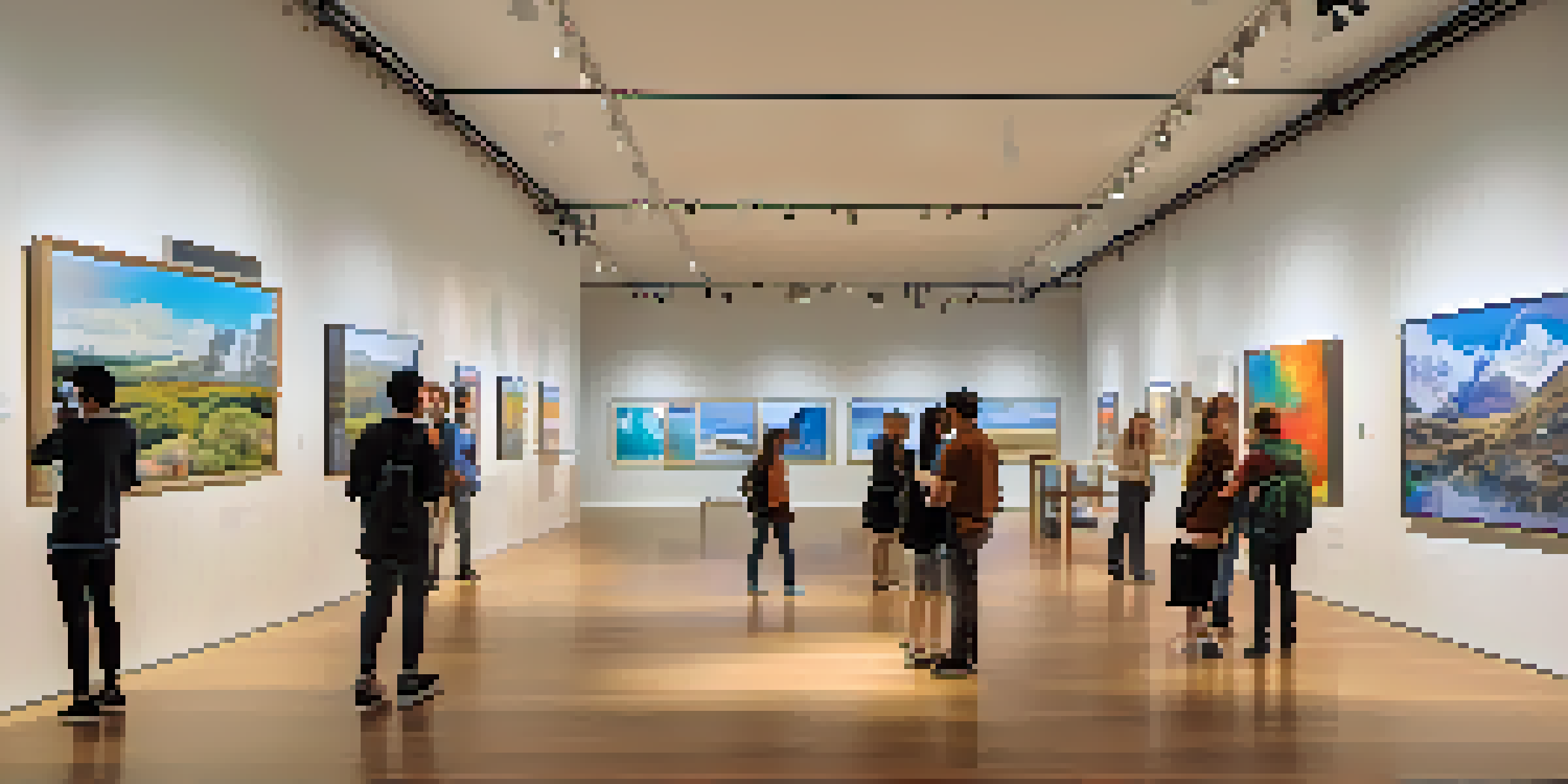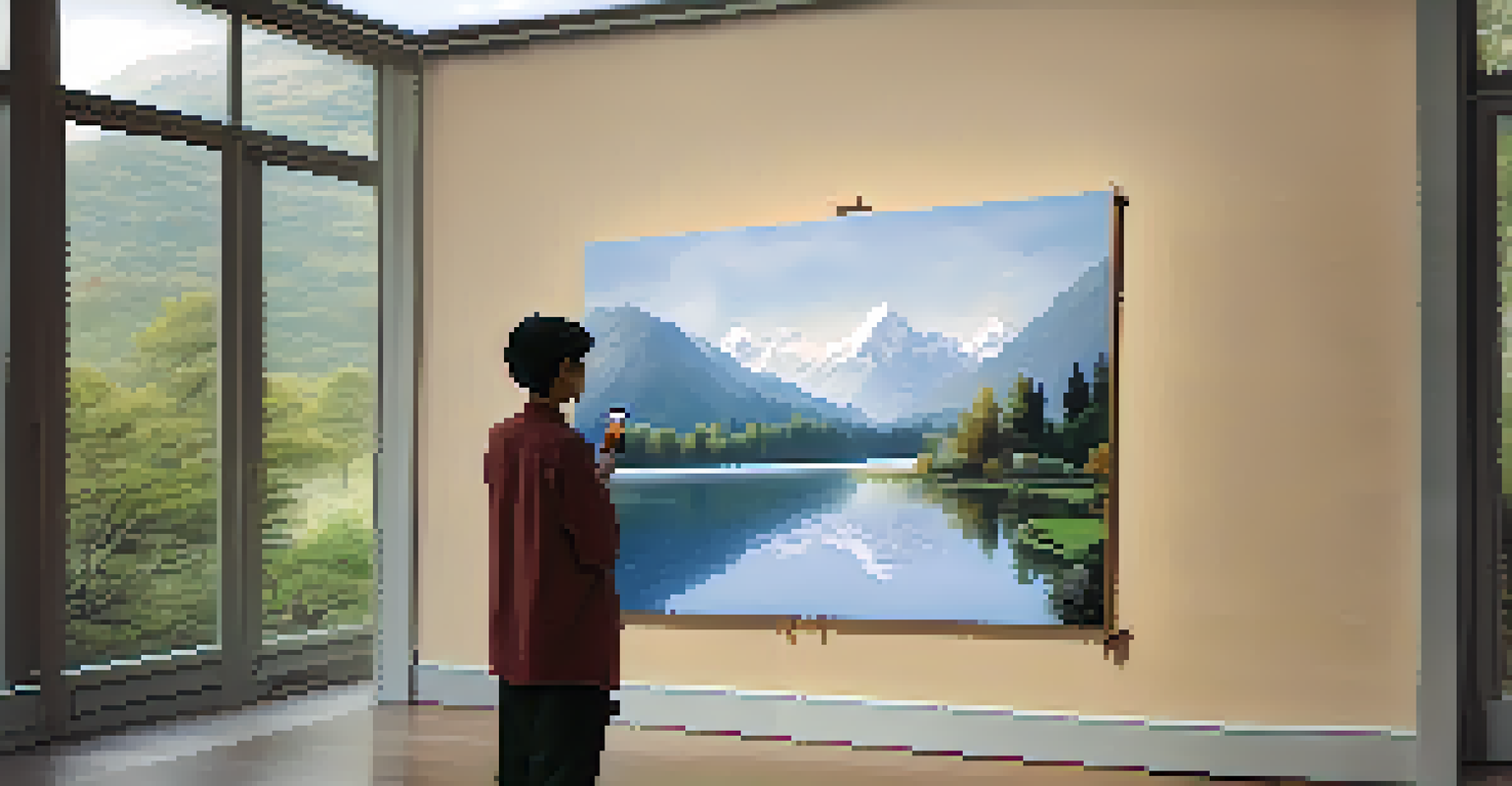Augmented Reality: Enhancing the Art Experience for Viewers

Understanding Augmented Reality in the Art World
Augmented Reality (AR) is a technology that superimposes digital information onto the real world, creating an interactive experience. In the art realm, AR allows viewers to see additional layers of information, animations, or even 3D models alongside physical artworks. Imagine standing in front of a painting and, with your smartphone, watching it come to life with moving elements or hearing the artist's narration about their inspiration.
Art is not what you see, but what you make others see.
This blending of digital and physical worlds not only enhances the viewing experience but also deepens the connection between the artwork and the audience. It allows for a richer understanding of the piece's context, history, and significance. For instance, a simple sculpture can unfold its story through a virtual tour that explains its cultural background and artistic technique.
As AR technology continues to develop, it opens up new avenues for artists and galleries alike to engage audiences in innovative ways. This engagement is not just about viewing art but experiencing it on a whole new level, making art more accessible and enjoyable for everyone.
How AR Creates Immersive Art Experiences
One of the most exciting aspects of AR is its ability to create immersive experiences that captivate viewers. For example, an AR app might allow you to step inside a digital recreation of a historic painting, letting you explore its elements up close. This kind of interaction transforms passive viewing into an active exploration, making art feel more dynamic and engaging.

Moreover, AR can bridge the gap between different forms of art. Imagine viewing a traditional painting that seamlessly integrates video or animation through your device. This fusion not only attracts tech-savvy audiences but also entices those who may not typically engage with art, broadening its appeal.
AR Enhances Art Accessibility
Augmented Reality makes art more reachable by offering features like voice descriptions and remote viewing opportunities.
Such immersive experiences also encourage viewers to share their encounters on social media, further amplifying the reach of the artwork. This creates a community of art lovers who can discuss and appreciate the work from different perspectives, enhancing collective engagement.
Enhancing Accessibility with Augmented Reality
Accessibility in art is a critical concern, and AR provides a solution by making art more reachable to diverse audiences. For instance, AR applications can offer voice descriptions or translations for viewers with disabilities, ensuring they can fully enjoy and understand the art. This level of inclusivity is vital in a world where art should be available to everyone, regardless of their background or abilities.
The future belongs to those who believe in the beauty of their dreams.
Additionally, AR can facilitate remote viewing opportunities. With the rise of virtual exhibitions, art lovers can explore galleries worldwide from the comfort of their homes. This not only saves time and travel costs but also allows people who may not have access to local galleries to experience art that otherwise would be out of reach.
By enhancing accessibility through technology, AR empowers a more inclusive art world, fostering appreciation and understanding among a wider audience. This shift is crucial for the future of art, as it embraces diversity and ensures that creative expression resonates with all.
Engaging the Younger Generation with AR
Today's younger generations are digital natives, often seeking interactive and engaging content. AR caters to this desire for interactive experiences, making art more relatable and fun for younger audiences. By incorporating AR into exhibitions, galleries can attract a demographic that might otherwise overlook traditional art forms.
For example, museums can host AR scavenger hunts, where visitors use their smartphones to find hidden elements in artworks. This gamification of art encourages exploration and learning in a playful manner, fostering a stronger connection between young viewers and the art they encounter.
Engaging Young Audiences with AR
AR attracts younger generations by creating interactive art experiences, such as gamified scavenger hunts in museums.
Furthermore, AR can serve as a platform for young artists to showcase their work. By using AR to present their art, they can reach wider audiences online, gaining recognition and shaping their narratives in innovative ways. This not only empowers artists but also cultivates a new generation of art enthusiasts.
The Role of Artists in AR Art Experiences
Artists play a crucial role in the integration of AR into the art experience. They are not just creators of physical artworks; they are also exploring digital mediums to express their visions. By embracing AR, artists can push the boundaries of their creativity, experimenting with new forms and narratives that engage viewers in unexpected ways.
Consider an artist who combines traditional painting techniques with AR elements to create a multi-sensory experience. When viewers scan the artwork with an app, they might trigger animations that reveal hidden layers or emotions behind the piece. This innovative approach not only showcases the artist's skill but also invites the audience to engage with the work on a deeper level.
As more artists experiment with AR, we will likely see a surge in collaborative projects that merge different artistic disciplines. This cross-pollination of ideas can lead to groundbreaking work that challenges conventional notions of art and expands the possibilities for viewer engagement.
Challenges and Limitations of AR in Art
While the potential of AR in art is exciting, it’s important to acknowledge the challenges that come with it. One major hurdle is the accessibility of technology itself; not everyone has a smartphone or the latest apps that support AR experiences. This digital divide can create disparities in who gets to experience these innovative art forms.
Additionally, there's the question of maintaining the authenticity of the original artwork. When digital elements are superimposed on a traditional piece, it can sometimes overshadow the artist's intention or the artwork's intrinsic value. Striking a balance between enhancing the viewing experience and preserving its original essence is crucial.
Artists Innovate with AR
Artists are exploring AR to push creative boundaries, blending traditional techniques with digital elements for deeper audience engagement.
Finally, as AR technology evolves rapidly, artists and institutions must stay informed and adapt to new tools and trends. This continuous learning curve can be daunting, but it’s essential for creating meaningful and impactful art experiences in this ever-changing landscape.
The Future of Augmented Reality in Art
Looking ahead, the future of AR in the art world is promising and filled with potential. As technology becomes more sophisticated and widely accessible, we can expect to see even more innovative applications of AR in galleries and museums. This could include everything from AI-generated artworks that interact with viewers to fully immersive virtual exhibitions.
Moreover, as artists continue to embrace AR, we will likely see a rise in hybrid art forms that blend traditional techniques with digital enhancements. This evolution of artistry could redefine how we perceive and interact with art, making the experience more engaging and transformative.

Ultimately, the continuous integration of AR in the art world presents an exciting opportunity to connect with audiences in profound ways. As we explore this uncharted territory, we can look forward to a future where art is not just seen but experienced, understood, and celebrated by all.